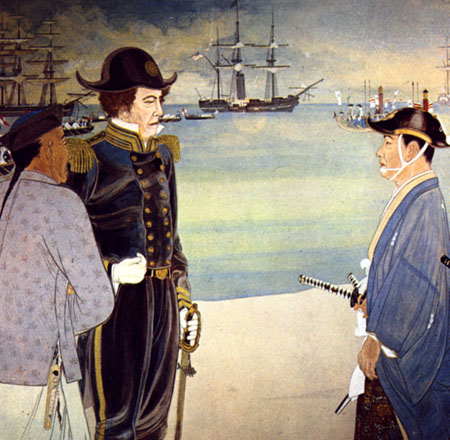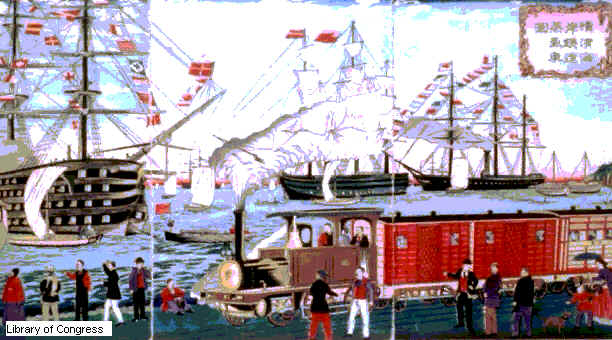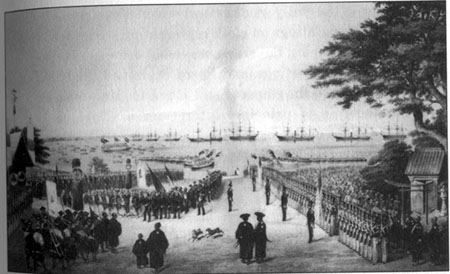During the Meiji period (1868-1912), the influx
of new ideas and technology had a sweeping impact on all areas of Japanese
life. At the same time, Japan still tried to hold onto its own cultural
identity. In the end a synthesis of the old and new would bring about
modern Japan.
 Many of the Japanese were quick to adopt western style both in their appearance
and actions. For example, the traditional Japanese hair cut for males
was the chomímage. This called for the head to be shaved except
for the rear, which was then pulled up and folded over the top of the head.
Thanks to its high maintenance and uncomfortable nature, it did not take
long for many men to switch to western hairstyles, especially those men
who were engaged in the new professions like school teacher, policeman,
or Meiji official. However, when the Meiji government finally came
out against the chomímage, some people fervently defended the old style.
There were even reports of mothers rejecting sons who came back from the
city or the army without their chomímage, and bridegrooms finding themselves
suddenly unworthy of their fiancées. (Shibusawa, 38)
Many of the Japanese were quick to adopt western style both in their appearance
and actions. For example, the traditional Japanese hair cut for males
was the chomímage. This called for the head to be shaved except
for the rear, which was then pulled up and folded over the top of the head.
Thanks to its high maintenance and uncomfortable nature, it did not take
long for many men to switch to western hairstyles, especially those men
who were engaged in the new professions like school teacher, policeman,
or Meiji official. However, when the Meiji government finally came
out against the chomímage, some people fervently defended the old style.
There were even reports of mothers rejecting sons who came back from the
city or the army without their chomímage, and bridegrooms finding themselves
suddenly unworthy of their fiancées. (Shibusawa, 38)
As with hairstyles, it was people in
the new professions and the army who took the lead in adopting western
clothes. Even then, in the cities, it was not uncommon to see someone
in a kimono with western shoes or in an obi worn with spectacles and an
umbrella. Traditional clothes remained in place though for those
engaged in traditional roles such as farming or fishing. It took
a longtime for the new ways to penetrate the countryside because there
was little reason to change, and actually, many of the changes in the villages
came from veterans returning from service and the young who had gone to
the city. (Shibusawa, 26)
The science and technology of the West
was quick to find its way into Japanese society. It was Commodore Perry
who demonstrated the telegraph to the imperial court in 1853. Soon
the first line was strung from Yokohama to Tokyo. However, many people
thought that there was black magic at work in the device. One rumor
said that the wires were soaked in the blood of unmarried women. Others
in the country were perplexed when they hung messages written on paper
from the wire and they did not fly down the line. Fear over the new technology
even led to riots in Hiroshima in 1871. It did not gain wide acceptance
right away because of these superstitions and the high cost of transmitting
messages and as such was primarily used by officials and the new newspapers.
(Shibusawa, 252)
Western thought had a tremendous impact on
Japanese culture at this time. With the establishment of the Institution
for Study of Barbarian Literature a steady stream of Western ideas and
entertainments were translated into Japanese. Samuel Smiles' book
Self Help and Lord Lyton's novel Ernest Moltavers became
huge successes in translation. Also several young men were sent to
study abroad in Europe and America under the Bureau of Western Learning.
They came back to Japan with the texts of John Stuart Mill, the Constitution
of the United States, German philosophers such as Hegel and Kant, and the
Social Darwinists for a country ready for new ideas. Ideas of economic
liberalism, the need for a market economy, and equality under the law resonated
with many in Japan's new generation. Fukuzawa Yukishi, the prolific
writer and great champion of westernization, said, "To abstain from intercourse
with foreign nations was a contradiction of both the laws of nature and
human nature." In the late 1850's English overtook Dutch as the most
studied Western language as the Japanese saw the source of enlightenment
shift to the West. (Yanaga, 70)

Industrialization and trade had a huge effect on the people's normal
everyday lives. For instance, once sake became an industry
it took on a much different place in society. Whereas sake
used to be primarily home-brewed and saved for special occasion, industrialization
had improved both the quality and quantity giving rise to the local tavern
and along with it many of the social ills accompanying alcohol. Beer
also made an introduction into Japanese life with advertising starting
as early as 1872. However alcohol abuse soon led to consumption laws
outlawing sales to minors in 1922 (Yamagida, p.41). Tea also
had changed in this new era. It was during this time that Japanese
started the enormous consumption of tea. No longer reserved for tea
ceremonies or special times, tea became a staple of Japanese life (Yamagida.
p 44). Along with the explosion in tea came an even bigger sensation
in sugar. Previously very expensive, with the newly opened ports
sweets of all kinds started appearing in shops in the cities. Sugar
became so popular it had to be rationed and only then was it spread into
the countryside.
Before 1853 Japan was not only
closed to the outside world, but within the country, even individual fiefs
were isolated from eachother. As such if one region suffered from
a poor harvest or natural disaster, the effect would be devastating, costing
many thousands of lives a year. (Shibusawa, 57) But with the breaking of
the feudal barriers both internal and external, the rural food supply could
finally be stabilized. Being able to import rice, which only then
became a staple of the Japanese diet, bolstered supplies even more.
Consumption of rice steadily increased, especially in the cities, and
by 1882 rice had become Japanís main export. The opening of the foreign
market had made production profitable, and this in turn helped to stabilize
the price at home.
In all these different areas, and throughout
Japanese civilization at this time people found themselves inundated with
ideas and technology and experiences that would have been only fantasy
a generation before. In each case, they found ways to apply new styles,
technology, and ideas to their pre-existing circumstances and to make something
new come from it. Japan was able to adapt with so ferociously and
completely because it did not want to be left behind in the world it had
just re-entered.
|
 This
report will focus on the changes that occurred in people's lives after
Commodore Perry opened Japan to the outside world in 1854. From that
point on, the country quickly shifted from an antiquated feudal society
to one that looked forward with hope and expectation. In the Meiji
Era, people's lives took a dramatic change in several areas. However,
there were many ways in which traditionalism was still retained by the
people especially in the countryside. By the end of the Meiji era,
a new Japanese culture had started to arise as a synthesis of the rapid
modernization and traditional culture.
This
report will focus on the changes that occurred in people's lives after
Commodore Perry opened Japan to the outside world in 1854. From that
point on, the country quickly shifted from an antiquated feudal society
to one that looked forward with hope and expectation. In the Meiji
Era, people's lives took a dramatic change in several areas. However,
there were many ways in which traditionalism was still retained by the
people especially in the countryside. By the end of the Meiji era,
a new Japanese culture had started to arise as a synthesis of the rapid
modernization and traditional culture.
 Many of the Japanese were quick to adopt western style both in their appearance
and actions. For example, the traditional Japanese hair cut for males
was the chomímage. This called for the head to be shaved except
for the rear, which was then pulled up and folded over the top of the head.
Thanks to its high maintenance and uncomfortable nature, it did not take
long for many men to switch to western hairstyles, especially those men
who were engaged in the new professions like school teacher, policeman,
or Meiji official. However, when the Meiji government finally came
out against the chomímage, some people fervently defended the old style.
There were even reports of mothers rejecting sons who came back from the
city or the army without their chomímage, and bridegrooms finding themselves
suddenly unworthy of their fiancées. (Shibusawa, 38)
Many of the Japanese were quick to adopt western style both in their appearance
and actions. For example, the traditional Japanese hair cut for males
was the chomímage. This called for the head to be shaved except
for the rear, which was then pulled up and folded over the top of the head.
Thanks to its high maintenance and uncomfortable nature, it did not take
long for many men to switch to western hairstyles, especially those men
who were engaged in the new professions like school teacher, policeman,
or Meiji official. However, when the Meiji government finally came
out against the chomímage, some people fervently defended the old style.
There were even reports of mothers rejecting sons who came back from the
city or the army without their chomímage, and bridegrooms finding themselves
suddenly unworthy of their fiancées. (Shibusawa, 38)
